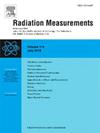iThemba实验室高能中子装置Ep = 66 MeV下7Li(p,n)7Be反应的中子剂量定量
IF 2.2
3区 物理与天体物理
Q2 NUCLEAR SCIENCE & TECHNOLOGY
引用次数: 0
摘要
iThemba加速器科学实验室(实验室)高能中子场的计量特征与蒙特卡罗辐射输运模拟相结合,以估计输送到人体血液小瓶的吸收剂量,该实验装置与在该设施进行放射生物学实验有关。用66.48 MeV质子束辐照8.0 mm锂靶,产生峰值能量为62.34(37)MeV的中子。利用BC-501A型液体闪烁探测器、238U裂变电离室和两台中子束监测器对发射角为0°和16°的中子束能量分布和通量进行了飞行时间测量。这些测量结果与在Geant4中开发的蒙特卡罗辐射传输模拟相结合,以计算在典型辐照期间,在距离目标4300米的距离放置在高密度聚乙烯模型中的四瓶人体血液中的吸收剂量。估计每单位监测计数给每个血瓶的吸收剂量,并结合监测计数率来确定吸收剂量率。根据小瓶在幻影中的位置,剂量率在0°时为24.36(78)mGy小时−1至26.22(84)mGy小时−1,在16°时为13.16(42)mGy小时−1至14.21(46)mGy小时−1。本文章由计算机程序翻译,如有差异,请以英文原文为准。
Quantification of neutron dose for the 7Li(p,n)7Be reaction at Ep = 66 MeV at the iThemba LABS high-energy neutron facility
A metrological characterisation of a high-energy neutron field at the iThemba Laboratory for Accelerator-Based Sciences (LABS) was combined with Monte Carlo radiation transport simulations to estimate the absorbed dose delivered to vials of human blood for an experimental setup relevant to conducting radiobiology experiments at this facility. Neutrons with a peak energy of 62.34(37) MeV were produced by a 66.48 MeV proton beam irradiating an 8.0 mm lithium target. The neutron beam energy distribution and fluence were characterised at emission angles of 0° and 16° via Time-of-Flight measurements with a BC-501A liquid scintillation detector, a 238U fission ionisation chamber, and two beam monitors. These measurements were combined with Monte Carlo radiation transport simulations developed in Geant4 to calculate the absorbed dose that would be delivered to four vials of human blood contained in high-density polyethylene phantoms placed at a distance of 4.300 m from the target during a typical irradiation. The absorbed dose delivered to each blood vial per unit monitor count was estimated and combined with measured monitor count rates to determine the absorbed dose rate. Depending on the vial position in the phantom, dose rates ranged from 24.36(78) mGy hour−1 to 26.22(84) mGy hour−1 at 0°, and from 13.16(42) mGy hour−1 to 14.21(46) mGy hour−1 at 16°.
求助全文
通过发布文献求助,成功后即可免费获取论文全文。
去求助
来源期刊

Radiation Measurements
工程技术-核科学技术
CiteScore
4.10
自引率
20.00%
发文量
116
审稿时长
48 days
期刊介绍:
The journal seeks to publish papers that present advances in the following areas: spontaneous and stimulated luminescence (including scintillating materials, thermoluminescence, and optically stimulated luminescence); electron spin resonance of natural and synthetic materials; the physics, design and performance of radiation measurements (including computational modelling such as electronic transport simulations); the novel basic aspects of radiation measurement in medical physics. Studies of energy-transfer phenomena, track physics and microdosimetry are also of interest to the journal.
Applications relevant to the journal, particularly where they present novel detection techniques, novel analytical approaches or novel materials, include: personal dosimetry (including dosimetric quantities, active/electronic and passive monitoring techniques for photon, neutron and charged-particle exposures); environmental dosimetry (including methodological advances and predictive models related to radon, but generally excluding local survey results of radon where the main aim is to establish the radiation risk to populations); cosmic and high-energy radiation measurements (including dosimetry, space radiation effects, and single event upsets); dosimetry-based archaeological and Quaternary dating; dosimetry-based approaches to thermochronometry; accident and retrospective dosimetry (including activation detectors), and dosimetry and measurements related to medical applications.
 求助内容:
求助内容: 应助结果提醒方式:
应助结果提醒方式:


